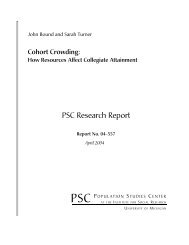Tracking metropolitan America into the 21st century - Population ...
Tracking metropolitan America into the 21st century - Population ...
Tracking metropolitan America into the 21st century - Population ...
You also want an ePaper? Increase the reach of your titles
YUMPU automatically turns print PDFs into web optimized ePapers that Google loves.
<strong>the</strong> MSA/CMSA combined list (276areas, including 258 MSAs and 18CMSAs), which was favored by OMBand <strong>the</strong> Census Bureau, or <strong>the</strong>MSA/PMSA combined list (331 areas,including 258 MSAs and 73 PMSAs),which common practice tended tofavor. Statistical rankings including<strong>metropolitan</strong> growth rates, crime statistics,employment patterns and qualityof life indicators in publicationssuch as <strong>the</strong> popular The Places RatedAlmanac used <strong>the</strong> MSA/PMSA system,as have most publications in Brookings’Living Cities Census Series. For<strong>the</strong> remainder of this report, we willalso use MSAs and PMSAs as benchmarksfor comparison with <strong>the</strong> newsystem.An additional choice faced analystsof <strong>metropolitan</strong> areas in <strong>the</strong> six NewEngland states. OMB defined MSAs,PMSAs, and CMSAs for <strong>the</strong>se states,as well as an alternative set of areasknown as New England County MetropolitanAreas (NECMAs). New EnglandMSAs, CMSAs, and PMSAs werebased on city and town componentsra<strong>the</strong>r than counties, but many analystswere unable to obtain relevantinformation at <strong>the</strong> town level. Hence,NECMAs were developed as countybasedcounterparts to New England’sconventional metro areas. Manynational analyses, <strong>the</strong>refore, usedMSAs, CMSAs, and PMSAs, outsideof New England, along with NECMAsinside <strong>the</strong> region.Finally, <strong>the</strong> previous standards didnot define any settlements outside of<strong>the</strong> <strong>metropolitan</strong> areas. All of <strong>the</strong> residualcounties in <strong>the</strong> United States (ortowns in New England) were labeled“non-<strong>metropolitan</strong>.” Some analystschose to use individual counties as ameans of distinguishing areas withinnon<strong>metropolitan</strong> territory. 10 Researchersat <strong>the</strong> Department of Agriculture createdRural-Urban Continuum Codes(“Beale Codes”) to distinguish amongnon-<strong>metropolitan</strong> counties based on<strong>the</strong>ir urban population and adjacencyto <strong>metropolitan</strong> areas. 11Metro Area Choices under <strong>the</strong>New StandardsFor those interested in comparing<strong>metropolitan</strong> areas across <strong>the</strong> country,<strong>the</strong>re is now really only one choice:<strong>the</strong> Metropolitan Statistical Area(designated in this paper as MetroSA).Although <strong>the</strong> new system allows forsome hierarchical choices for analysesof individual areas (discussed below),inter-<strong>metropolitan</strong> analyses are bestconducted using <strong>the</strong> MetroSA, whichnow is based exclusively on countylevelcomponents in both New Englandand non-New England states.MetroSAs are defined using somewhatdifferent criteria than <strong>the</strong> old MSAs,CMSAs, and PMSAs. As a consequence,both <strong>the</strong> size and number of<strong>metropolitan</strong> areas have changed.According to <strong>the</strong> new standards,<strong>metropolitan</strong> area central counties,which form <strong>the</strong> basis for determiningoutlying counties via commuting patterns,are now determined exclusivelyby <strong>the</strong>ir overlap with urban areas of allsizes so that <strong>the</strong> more restrictive“urbanized areas or cities of 50,000 ormore” criterion is no longer part of<strong>the</strong>ir definition. 12 The extent of urbanareas has also changed, due to populationgrowth and new definitional criteria.Toge<strong>the</strong>r, <strong>the</strong>se changes haveincreased <strong>the</strong> number of central counties,thus enlarging <strong>the</strong> potential commutingfields of many large<strong>metropolitan</strong> areas. 13At <strong>the</strong> same time, new commutingcriteria for adding outlying counties toa region’s central counties are morerestrictive than those used previously.Thus, 41 counties which previouslyserved as outlying counties of <strong>metropolitan</strong>areas do not qualify as suchunder <strong>the</strong> new rules, but have nowbecome part of new micropolitanareas.One result of <strong>the</strong> change in criteriafor defining <strong>metropolitan</strong> areas is that<strong>the</strong> larger MetroSAs are more comparablein size and area to <strong>the</strong> formerCMSAs than to <strong>the</strong> former PMSAs. 14As a consequence, users who areaccustomed to employing <strong>the</strong>PMSA/MSA definitions under <strong>the</strong> oldsystem will find that <strong>the</strong> number of<strong>metropolitan</strong> areas with populationsexceeding one million drops from 61to 49 in <strong>the</strong> new system. At <strong>the</strong> sametime, <strong>the</strong> number of <strong>metropolitan</strong>areas with populations less than250,000 rises from 149 to 195. Yet,<strong>the</strong> 49 large MetroSAs comprise about<strong>the</strong> same share of <strong>the</strong> U.S. population—53percent—as <strong>the</strong> 61 largeMSAs/PMSAs (Figure 4). At <strong>the</strong> o<strong>the</strong>rend of <strong>the</strong> size spectrum, <strong>the</strong> 195small Metro SAs comprise only aslightly larger share of U.S. populationthan <strong>the</strong> 149 small MSAs/PMSAs (10percent versus 8 percent).Altoge<strong>the</strong>r, <strong>the</strong> new standardsdescribe 361 MetroSAs, comparedto 331 MSAs/PMSAs under <strong>the</strong> oldsystem.As with <strong>the</strong> previous standards,OMB defines an alternative set ofareas in <strong>the</strong> six New England states.Unlike <strong>the</strong> old standards, however,<strong>the</strong>se alternative areas are defined at<strong>the</strong> city and town level and are calledNew England City and Town Areas(NECTAs). MetroSAs in New Englandare comprised of counties, makingcounties <strong>the</strong> basic “buildingblocks” of <strong>metropolitan</strong> areas bothinside and outside <strong>the</strong> New Englandstates.Finally, <strong>the</strong> most recognizablechange with <strong>the</strong> new standards is <strong>the</strong>identification of smaller “<strong>metropolitan</strong>like”communities. These new areas,called micropolitan areas, define meaningful“core-based” areas with corestoo small to qualify as MetroSAs. Theyare discussed in finding B.The New Hierarchy Options forLocal AreasWhile <strong>the</strong> new standards provide a singleunit, <strong>the</strong> MetroSA, for comparing<strong>metropolitan</strong> areas across <strong>the</strong> country,<strong>the</strong>y provide additional choices when<strong>the</strong> focus turns to local areas (Figure5). Combined Statistical Areas(CSAs) represent two or more adjoin-November 2004 • The Brookings Institution The Living Cities Census Series 5















